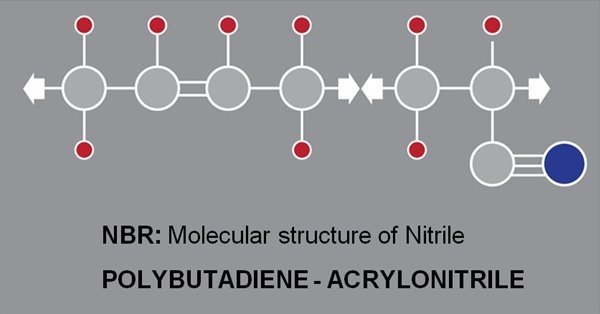NBR
Nitrile rubber is a synthetic copolymer elastomer produced by emulsion copolymerization of acrylonitrile monomer and butadiene in the presence of free radicals.

NBR - nitrile butadiene
Nitrile rubber is a synthetic copolymer elastomer produced by emulsion copolymerization of acrylonitrile monomer and butadiene in the presence of free radicals.
Nitrile rubber is generally used in the temperature range of -40 to 110 degrees Celsius. It is very widely used for the production of o-rings and sealing accessories
code
BTNB85
hardship level
85
Color
Black
Temperature range
-40°C to +110°C -
Description
data sheet
Nitrile rubber is a synthetic copolymer elastomer produced by emulsion copolymerization of acrylonitrile monomer and butadiene in the presence of free radicals. Nitrile rubber has two types, hot and cold, which are named according to the polymerization temperature. Despite the presence of acrylonitrile in its structure, nitrile rubber is not toxic because this material is not ionized even in water and does not produce cyanide ions.
Acrylonitrile is a type of cyanide which is a deadly poison. In fact, nitrile rubber molecules dissolve in water without disintegrating. In the production process of nitrile rubber, according to the expected properties of the rubber, the amount of the acrylonitrile part of the rubber is selected from 15 to 50%.
Different grades of NBR nitrile rubber
- High nitrile: More than 45% nitrile
- Nitrile Medium: 30 to 45% nitrile
- Low nitrile: Less than 30% nitrile
Nitrile rubber is mostly known for its excellent oil resistance. It is also a tough and heat-resistant polymer. The oil resistance of nitrile rubber is influenced by the amount of acrylonitrile part of the structure. The higher the amount of acrylonitrile, the greater the resistance of the rubber to swelling due to oil, the strength increases and the permeability to gases decreases. On the other hand, reducing the amount of acrylonitrile increases the flexibility at low temperature. Nitrile rubber with a low percentage of acrylonitrile is known as a heat-resistant, strong and resilient polymer.
Nitrile rubber is generally used in the temperature range of -40 to 110 degrees Celsius. This rubber is 3 times more resistant to punctures than natural rubber and is also resistant to cuts, abrasions, tears, corrosive substances and aliphatic hydrocarbons. But it is less flexible than natural rubber. Nitrile rubber is cheaper than fluoroelastomers. Hydrogenated nitrile is resistant to heat and oxidation and flexible at low temperature.
On the other hand, nitrile rubber is limited in external conditions and in contact with air and is sensitive to some chemicals. This rubber reacts against ozone, light and weather and has very low flame resistance. Also, nitrile rubber catches fire in contact with nitric acid and oxidizers and cannot be used in contact with chlorinated hydrocarbons or polar solvents. In order to improve physical properties and thermal resistance, nitrile rubber (XNBR) is carboxylated.
